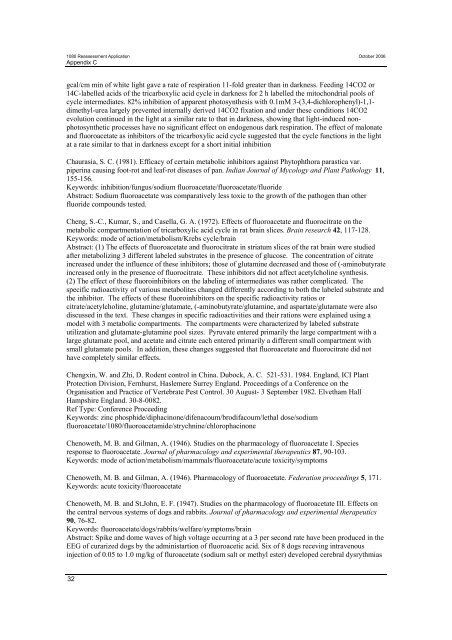Source: Landcare Research (1964). Control of poisons. Royal ...
Source: Landcare Research (1964). Control of poisons. Royal ...
Source: Landcare Research (1964). Control of poisons. Royal ...
Create successful ePaper yourself
Turn your PDF publications into a flip-book with our unique Google optimized e-Paper software.
1080 Reassessment Application October 2006<br />
Appendix C<br />
gcal/cm min <strong>of</strong> white light gave a rate <strong>of</strong> respiration 11-fold greater than in darkness. Feeding 14CO2 or<br />
14C-labelled acids <strong>of</strong> the tricarboxylic acid cycle in darkness for 2 h labelled the mitochondrial pools <strong>of</strong><br />
cycle intermediates. 82% inhibition <strong>of</strong> apparent photosynthesis with 0.1mM 3-(3,4-dichlorophenyl)-1,1dimethyl-urea<br />
largely prevented internally derived 14CO2 fixation and under these conditions 14CO2<br />
evolution continued in the light at a similar rate to that in darkness, showing that light-induced nonphotosynthetic<br />
processes have no significant effect on endogenous dark respiration. The effect <strong>of</strong> malonate<br />
and fluoroacetate as inhibitors <strong>of</strong> the tricarboxylic acid cycle suggested that the cycle functions in the light<br />
at a rate similar to that in darkness except for a short initial inhibition<br />
Chaurasia, S. C. (1981). Efficacy <strong>of</strong> certain metabolic inhibitors against Phytophthora parastica var.<br />
piperina causing foot-rot and leaf-rot diseases <strong>of</strong> pan. Indian Journal <strong>of</strong> Mycology and Plant Pathology 11,<br />
155-156.<br />
Keywords: inhibition/fungus/sodium fluoroacetate/fluoroacetate/fluoride<br />
Abstract: Sodium fluoroacetate was comparatively less toxic to the growth <strong>of</strong> the pathogen than other<br />
fluoride compounds tested.<br />
Cheng, S.-C., Kumar, S., and Casella, G. A. (1972). Effects <strong>of</strong> fluoroacetate and fluorocitrate on the<br />
metabolic compartmentation <strong>of</strong> tricarboxylic acid cycle in rat brain slices. Brain research 42, 117-128.<br />
Keywords: mode <strong>of</strong> action/metabolism/Krebs cycle/brain<br />
Abstract: (1) The effects <strong>of</strong> fluoroacetate and fluorocitrate in striatum slices <strong>of</strong> the rat brain were studied<br />
after metabolizing 3 different labeled substrates in the presence <strong>of</strong> glucose. The concentration <strong>of</strong> citrate<br />
increased under the influence <strong>of</strong> these inhibitors; those <strong>of</strong> glutamine decreased and those <strong>of</strong> (-aminobutyrate<br />
increased only in the presence <strong>of</strong> fluorocitrate. These inhibitors did not affect acetylcholine synthesis.<br />
(2) The effect <strong>of</strong> these fluoroinhibitors on the labeling <strong>of</strong> intermediates was rather complicated. The<br />
specific radioactivity <strong>of</strong> various metabolites changed differently according to both the labeled substrate and<br />
the inhibitor. The effects <strong>of</strong> these fluoroinhibitors on the specific radioactivity ratios or<br />
citrate/acetylcholine, glutamine/glutamate, (-aminobutyrate/glutamine, and aspartate/glutamate were also<br />
discussed in the text. These changes in specific radioactivities and their rations were explained using a<br />
model with 3 metabolic compartments. The compartments were characterized by labeled substrate<br />
utilization and glutamate-glutamine pool sizes. Pyruvate entered primarily the large compartment with a<br />
large glutamate pool, and acetate and citrate each entered primarily a different small compartment with<br />
small glutamate pools. In addition, these changes suggested that fluoroacetate and fluorocitrate did not<br />
have completely similar effects.<br />
Chengxin, W. and Zhi, D. Rodent control in China. Dubock, A. C. 521-531. 1984. England, ICI Plant<br />
Protection Division, Fernhurst, Haslemere Surrey England. Proceedings <strong>of</strong> a Conference on the<br />
Organisation and Practice <strong>of</strong> Vertebrate Pest <strong>Control</strong>. 30 August- 3 September 1982. Elvetham Hall<br />
Hampshire England. 30-8-0082.<br />
Ref Type: Conference Proceeding<br />
Keywords: zinc phosphide/diphacinone/difenacoum/brodifacoum/lethal dose/sodium<br />
fluoroacetate/1080/fluoroacetamide/strychnine/chlorophacinone<br />
Chenoweth, M. B. and Gilman, A. (1946). Studies on the pharmacology <strong>of</strong> fluoroacetate I. Species<br />
response to fluoroacetate. Journal <strong>of</strong> pharmacology and experimental therapeutics 87, 90-103.<br />
Keywords: mode <strong>of</strong> action/metabolism/mammals/fluoroacetate/acute toxicity/symptoms<br />
Chenoweth, M. B. and Gilman, A. (1946). Pharmacology <strong>of</strong> fluoroacetate. Federation proceedings 5, 171.<br />
Keywords: acute toxicity/fluoroacetate<br />
Chenoweth, M. B. and St.John, E. F. (1947). Studies on the pharmacology <strong>of</strong> fluoroacetate III. Effects on<br />
the central nervous systems <strong>of</strong> dogs and rabbits. Journal <strong>of</strong> pharmacology and experimental therapeutics<br />
90, 76-82.<br />
Keywords: fluoroacetate/dogs/rabbits/welfare/symptoms/brain<br />
Abstract: Spike and dome waves <strong>of</strong> high voltage occurring at a 3 per second rate have been produced in the<br />
EEG <strong>of</strong> curarized dogs by the administartion <strong>of</strong> fluoroacetic acid. Six <strong>of</strong> 8 dogs receving intravenous<br />
injection <strong>of</strong> 0.05 to 1.0 mg/kg <strong>of</strong> fluroacetate (sodium salt or methyl ester) developed cerebral dysrythmias<br />
32








![Application for test certificate [pdf, 131kb]](https://img.yumpu.com/50666502/1/184x260/application-for-test-certificate-pdf-131kb.jpg?quality=85)








